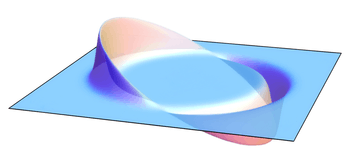Interdimensional being
An extradimensional being or intelligence (also intra-dimensional[1] and other-dimensional[1]) is a type of theoretical or fictional entity existing in a dimension beyond our own. Such beings are common in science fiction.
Nonfiction
Nonfictional theoretical implementations

A theoretical type of starship engine, the Alcubierre drive, emulates superluminal travel by manipulating the fabric of spacetime. This can be achieved by amassing large quantities of pure energy in a section of spacetime.
However, the quantity of energy required would be completely impractical. Albert Einstein's theories certainly imply that the energy could be carried around as mass, yet the exact implementation of releasing the energy using materials other than antimatter is not terribly clear.
Since the Alcubierre drive manipulates spacetime, it is the closest theoretical space travel engine to interdimensional travel. Because modern science on Earth does not have a real concept of multiple dimensions beyond quantum mechanics and the many worlds interpretation, bending or changing spacetime itself to achieve faster-than-light travel appears to be the real-world equivalent of jumping through dimensional doorways in fiction.
Fiction
Implementation of dimensional portals
In the Star Trek universe, wormhole theory states that if a section in the fabric of spacetime joins together with another section of spacetime, a direct connection can be made between the two, allowing speedy travel between the two (normally unrelated) spacetime coordinates. Black holes are one such way of stretching the fabric of spacetime; so it's theoretically possible to create wormholes using a pair of singularities, at least in the fictional universe of Star Trek.[2] The NASA Web site has a somewhat dated article called "The Science of Star Trek", by physicist David Allen Batchelor (5 May 2009), which considers some of the implementations in Star Trek. He says it's "the only science fiction series crafted with such respect for real science and intelligent writing", with some "imaginary science" mixed in; and considers it to be the "only science fiction series that many scientists watch regularly", like himself. He says it's "more faithful to science than any other science fiction series ever shown on television".[3]
Universe dimensionality
An additional fictional work that does include universe dimensionality of some sort includes the Buffy the Vampire Slayer series, according to a particular academic source.[4]
In literature
The Time Machine (H. G. Wells)
The Time Machine by H. G. Wells describes time travelers as interdimensionally capable.
The protagonist describes the passing of time, and also treats it as if it were a spatial dimension. This is exactly how H. G. Wells devises the time machine mechanism in this particular work of fiction. H. G. Wells supposes that if time could simply be treated as space, then time machines would indeed operate correctly.[5] In this case, the H. G. Wells definition of a time traveler must be equivalent to that of an interdimensional being – an entity capable of traveling through unusual dimensional rifts that few other entities can enter.
From H. G. Wells' Work: 'Clearly,' the Time Traveller proceeded, 'any real body must have extension in four directions: it must have Length, Breadth, Thickness, and—Duration. But through a natural infirmity of the flesh, which I will explain to you in a moment, we incline to overlook this fact. There are really four dimensions, three which we call the three planes of Space, and a fourth, Time. There is, however, a tendency to draw an unreal distinction between the former three dimensions and the latter, because it happens that our consciousness moves intermittently in one direction along the latter from the beginning to the end of our lives.
The Hitchhiker's Guide to the Galaxy (Douglas Adams)
The Hitchhiker's Guide to the Galaxy by Douglas Adams describes that mice are 'merely the protrusion into our dimension of vast hyper-intelligent pan-dimensional beings.' The old man, Slartibartfast, from Magrathea told the protagonist, Arthur, that the planet he lived on, Earth, 'was commissioned, paid for, and run by mice.' and that the mice were furious when it was destroyed.
References
- 1 2 Coppens, Philip (2012). The Ancient Alien Question: A New Inquiry Into the Existence, Evidence, and Influence of Ancient Visitors. Pompton Plains, NJ: New Page Books, A Division of The Career Press, Inc. pp. 126, 268, 273, and 274 in the e–book version. The term "intra–dimensional" was suggested by George Lucas (pg. 126). ISBN 978-1-60163-628-7.
- ↑ "Black Holes in Star Trek: Science Fact and Fiction" (PDF).
- ↑ Batchelor, David. "The Science of Star Trek". Retrieved 31 January 2013.
- ↑ Glenn Yeffeth. Seven Seasons of Buffy. BenBella Books. ISBN 978-1-932100-08-2.
- ↑ "The Time Machine by H. G. Wells – Full Text".
Additional sources used
- Suppression and Transformation of the Maternal in Contemporary Women's Science Fiction
- Portals in Science Fiction (Google Scholar)